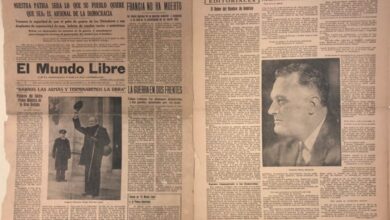Tutankhamun bust and other objects that Egypt claims to Europe
The auction house Christie's sold Tutankhamun bust despite criticism from the Egyptian Government

Tutankhamun bust auctioned at Christie's for nearly USD $6 million
LatinAmerican Post | Juan Gabriel Bocanegra
Listen to this article
Leer en español: La subasta del busto de Tutankamón y otros objetos que Egipto reclama a Europa
Beyond being a cultural heritage for humanity, ancient art also has a pecuniary value that increases the status of nations and magnates. The last scandal surrounding a sale of such an object took place on July 4 at the Christie's auction house, whose base is in London.
The object in question was Tutankhamun bust, more than 3 thousand years old, which was part of the Resandro collection. The price of the auction started at 5 million dollars and ended at 6 million dollars.
Made of red quartzite and with a height of 28.5 cm, the bust represents the god Amen with features of the pharaoh Tutankhamun, such as shaped eyes and the superior protuberant. As Christie's herself recalls in a video on its page, "the pharaoh would use this tool for the propaganda to show his image throughout the country. It was the perfect way of having himself associated with a deity and the power that it represents”.
Since before the sale began, the Egyptian Government had already exercised diplomatic pressure on the sale of this bust and other antiquities. The ministry of Antiquities published in June a statement where they said: "once again, we will not be negligent nor allow anyone to sell any Egyptian artifact at all."
Another of the top critics of this sale was the archeologist and former minister of antiquities, Zahi, Hawass, recognized for his open struggle against museums around the world that have Egyptian antiquities. In statements collected by Infobae, he assured that the piece "left Egypt in the 1970s because at that time other ancient objects of the same nature were stolen from the temple of Karnak." "Christie's cannot tell us when it was stolen. And the owners provided false information," he told RFI.
Christie's denied what was said by the Egyptian representatives saying that the piece had been obtained from a collector who owned the bust since the 60s and that "we would not sell any object whose property or export generates doubts," according to a spokesman for the house interviewed by the French chain.
The reaction to the sale was not only from the official sector but also from the Egyptian civilian population itself. This was demonstrated with the manifestations in front of the auction house on the day of the sale, who had banners that said: "stop the trade of stolen antiquities".
Protesting Egyptians in front of #christies during the #auction sale with an #ancientegyptian #amun head with features of #tutankhamun that finally sold for 4m. pic.twitter.com/LYLdrVxbw7
— Sycomore Ancient Art (@s_y_c_o_m_o_r_e) 4 de julio de 2019
The protesters are part of the 'Egyptian House' group, recalls ABC, who are not against the sale of antiques, but rather about the private purchase of collectors. As Magda Sakr, a protester, told the AFP referring to Tutankhamun bust, "it should not be in a house, it should be in a museum".
Despite the failure to stop the auction at Christie's, the political pressure of the Egyptian government has worked in other cases. For example, in February of this year, according to the website of the Egyptian State Information Service, the German authorities returned eight objects that had been confiscated in Bavaria. These are mainly everyday objects like jars from the late Pharaonic period of Egypt.
You may be interested: A Picasso sold during Nazi flight can stay at New York's Met – U.S. Court
Other antiques in European hands
Although they have succeeded in recovering some objects, the most representative Egyptian antiquities remain part of foreign collections. From the position of Zahi Hawass, "every piece that has been stolen from Egypt should come back". This was stated in a documentary by Natgeo.
It is difficult to determine if the piece was stolen or not because only until 1983 Egypt ruled that all excavated objects should remain in the national territory. Although now it works that way, reflects Nuria Castellano, a consultant for ancient art exhibitions interviewed for 20 Minutos, "I do not know if it [the law] can be applied retroactively. When the British Museum or the Louvre acquired these treasures, everything was legal. And dismantling now museums with such a tradition would be practically unfeasible."
In this sense, there is an interpretive gap between the legality and illegal possession of objects obtained many years ago, mainly those dating from the boom of Egyptian art during the nineteenth and early twentieth centuries.
One of the most precious objects that are outside of Egypt is Rosetta Stone, probably the Egyptian antiquity of greater economic and cultural value, which is currently in the rooms of the British Museum in London.
On the stone, which weighs almost a ton, there are writings in Greek and hieratic hieroglyphics. In fact, it was because of Rosetta Stone that ancient archaeologists managed to decipher Egyptian hieroglyphs in the nineteenth century. It was Napoleon who initially took the stone out of the country after the invasion in 1799 and later, in 1801, when the English defeated the French army, it was taken to the United Kingdom.
The bust of Nefertiti is another antiquity highly coveted by the Egyptians that is currently guarded by the Neues Museum in Berlin. Nefertiti, whose name means "the beautiful one has come", was the wife of Pharaoh Akhnaton who ruled between 1353 and 1336 B.C. It was discovered in 1912 by the German archaeologist Ludwig Borchardt and, since 1924, it has been exhibited in German museums.
Finally, there is the statue of the possible architect of the pyramids of Giza, and the pharaoh of the fourth dynasty around 2580 B.C, Hemiunu, which is currently part of the catalog of the Roemer-Pelizaeus Museum in Hildesheim. The statue of realistic features made in limestone was excavated by Hermann Junker in 1912 that was part of the German-Austrian Expedition. After that, it has always remained in German territory.





